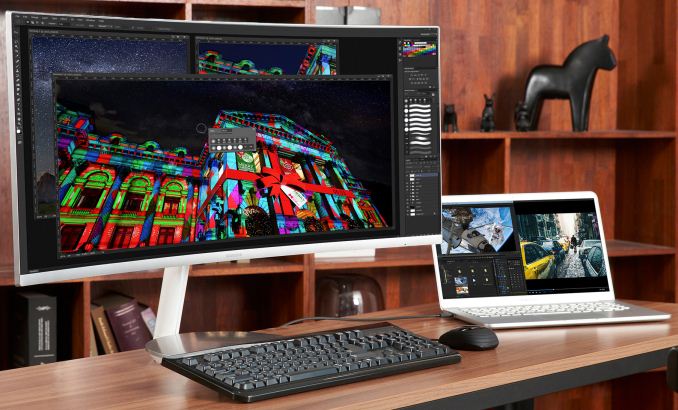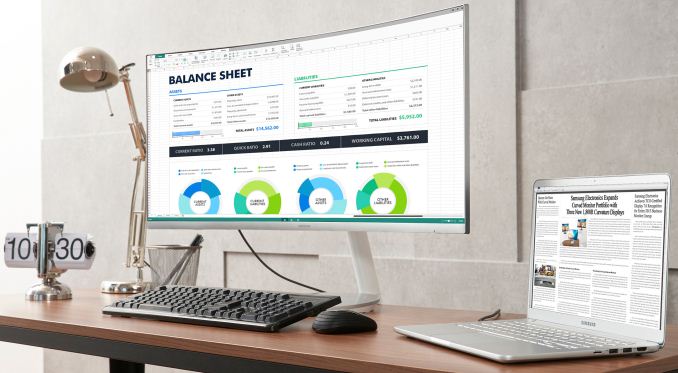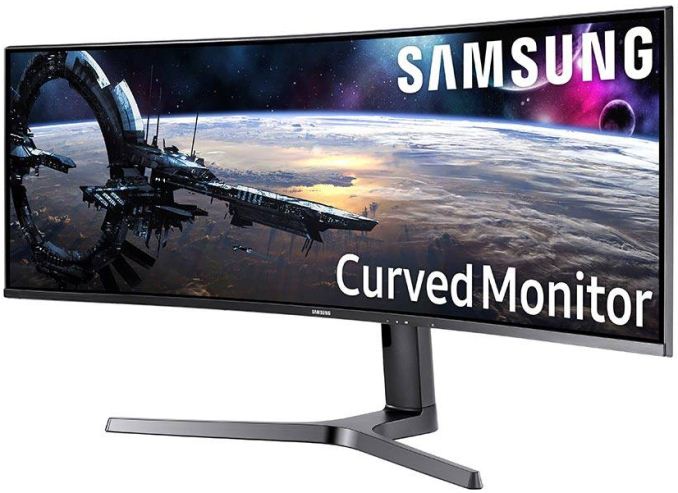Samsung Unveils CJ79 & CJ89 Curved LCDs: Quantum Dots, TB3 & USB-C
by Anton Shilov on August 29, 2018 9:00 AM EST
Samsung this week introduced its new CJ79 and CJ89-series curved displays, which are aimed at home and office audiences. The ultrawide CJ79 34-inch monitor features Samsung’s QLED backlighting to offer a wider color gamut, AMD’s FreeSync variable refresh technology, as well as Thunderbolt 3 inputs for compatibility with the latest notebooks. Meanwhile, the CJ89-series monitors are available in 43 and 49-inch sizes, and unlike the 34-inch model, uses USB Type-C connectivity instead. Similarly (and unexpectedly), while the larger LCDs feature refresh rates between 120 Hz and 144 Hz depending on the model, they do not support any dynamic refresh rate technology.
The Samsung CJ79 (C34J791) display is based on a 34-inch curved VA panel featuring a 3440×1440 resolution, a 21:9 aspect ratio, a 300 nits brightness (typical), a 3000:1 contrast ratio, a 1500R curvature, 178°/178° viewing angles, as well as a 100 Hz refresh rate with AMD’s FreeSync technology (precise ranges unknown). One of the key selling points of this monitor is its QLED backlighting (with quantum dots) to guarantee coverage of up to 92% of the AdobeRGB color space. Another important feature is Thunderbolt 3 connectivity accompanied by more regular DisplayPort 1.2 and HDMI 2.0 inputs. Besides, the monitor has a dual-port USB hub and stereo speakers.
The CJ79-series 34-inch display will be positioned as Samsung’s performance mainstream offering for home users seeking a large, high refresh rate monitor premium features like QLED and FreeSync, as well as rich connectivity options. As a bonus feature, the C34J791 covers up to 92% of the AdobeRGB color gamut, though it is doubtful that professional photographers will use an LCD supporting only 16.7 million of colors for their work.
Moving on to the larger Samsung CJ89 displays based on 43-inch (3840×1200) and 49-inch (3840×1080) VA panels and featuring a 32:10 as well as a 32:9 ultrawide aspect ratio, respectively. Both monitors sport a 300 nits brightness, a 3000:1 contrast ratio, a 1800R curvature, 178°/178° viewing angles, as well as a 120 Hz (43-inch) or 144 Hz (49-inch) refresh rate, but without FreeSync. These LCDs connect to hosts using USB Type-C or traditional DisplayPort 1.2 as well as HDMI 2.0 cables. Meanwhile, the larger CJ-series LCDs feature a five-port USB hub comprising of two USB Type-C headers, two USB 2.0 Type-A connectors, and one USB 3.0 Type-A port. Besides, just like the smaller LCD, the big ones come with stereo speakers.
All three displays are outfitted with stands that can adjust height and tilt, but only the larger CJ89-series LCDs can also adjust swivel. Being large monitors, the new CJ79 and CJ89-series fully support such capabilities as PiP and PbP and can work with more than one PC at once. Moreover, the C49J890 even has a built-in KVM switch allowing users to control two PCs using one keyboard and one mouse while working in PbP mode.
| Samsung CJ79 & CJ89 Series | ||||
| C34J791 | C43J89 | C49J890 | ||
| Panel | 34" VA | 43" VA | 49" VA | |
| Native Resolution | 3440 × 1440 | 3840 × 1200 | 3840 × 1080 | |
| Refresh Rate | 100 Hz | 120 Hz | 144 Hz | |
| Dynamic Refresh Rate | Technology | AMD FreeSync | - | |
| Range | ? | - | - | |
| Response Time | 4 ms (gray-to-gray) | 5 ms (gray-to-gray) | ||
| Brightness | 300 cd/m² | |||
| Contrast | 3000:1 | |||
| Color Gamut | 125% sRGB 92% AdobeRGB 88% NTSC 1976 |
? | ? | |
| Viewing Angles | 178°/178° horizontal/vertical | |||
| Curvature | 1500R | 1800R | ||
| Inputs | 1 × DisplayPort 1.2 1 × HDMI 2.0 2 × Thunderbolt 3 |
1 × HDMI 2.0 1 × DisplayPort 1.2 1 × USB-C |
||
| USB Hub | 2 × USB Type-A | 2 × USB 2.0 Type-A 1 × USB 3.0 Type-A 1 × USB Type-C |
||
| Audio | 1 × 3.5-mm audio jack for headphones 1 × 3.5-mm audio jack for input 2 × stereo speakers |
|||
| Proprietary Enhancements | - | - | Integrated KVM switch | |
| Stand | Height | 100.0 ± 5.0 mm | 120.0 ± 5.0 mm | |
| Tilt | Top: -14˚(±4˚)~22˚(±4˚) Bottom: -2˚(±4˚)~34˚(±4˚) | -2.0° (±2.0°) ~ +17.0° (±2.0°) | -2.0° (±2.0°) ~ +15.0° (±2.0°) |
|
| Swivel | - | -15.0° (±2.0°) ~ +15.0° (±2.0°) | 15.0° (±2.0°) ~ +15.0° (±2.0°) |
|
| Power Consumption | Idle | ~0.3 W | ||
| Typical | 65 W | 59 W | 62 W | |
| Maximum | 180 W | 220 W | ||
Samsung’s CJ79 and CJ89 monitors are already available in select European markets and will hit store shelves in other countries in the coming weeks or months. When it comes to pricing, the new units are not cheap at all. The C34J791 is currently available for pre-order for €878 ($1029, including VAT) from Amazon.de, meanwhile, the C49J890 is priced at €879 ($1030, including VAT) and higher, according to Geizhals.at.
Related Reading:
- Samsung Announces First Freesync 2 Monitors: CHG70 & CHG90 - Quantum Dots, Up to 49”, 144 Hz, DCI-P3
- BenQ Unveils EX3203R 32-inch Curved LCD with FreeSync 2, DCI-P3, & USB-C
- LG Announces 32UD99: 4K IPS Display with 95% DCI-P3, HDR and USB-C
- LG Introduces New UltraFine 4K and 5K Monitors
- Philips Brilliance 328P6AU QHD Display Launched: USB-C Dock, 99% AdobeRGB, Color Calibrated
- Philips Readies Curved Ultra-Wide 492P8 Display: 49”, 32:9, USB-C, Sub-$1100
- Philips Demos 328P8K: 8K UHD LCD with Webcam, Docking, Coming in 2018
Source: Samsung














13 Comments
View All Comments
Tyler_Durden_83 - Wednesday, August 29, 2018 - link
Asus RoG STRIX?PeachNCream - Wednesday, August 29, 2018 - link
Looks like a copy+paste omission.MarcusMo - Wednesday, August 29, 2018 - link
Yeah, never again a VA panel in this wide format. Bought one of the last gen 34-inch models and the contrast dropoff inherent in this tech makes it almost impossible to position your head in a spot where you don’t have a massive gradient in any grayscale material. 34 inches is just to wide for this not to be an issue. Agressive curvature mitigates this to a certain degree, as it keeps your viewing angle more consistent across the display surface, but not nearly enough. Stay away from this if your doing even the slightest bit of design or color sensitive work or if you are just sensitive to contrast shifts in general.IPS displays are much more compelling for these wide formats.
imaheadcase - Wednesday, August 29, 2018 - link
Well if you are doing content based work you wouldn't get a curved anyway..so..yah.Dug - Wednesday, August 29, 2018 - link
Or color sensitive work. But the Samsung CF791 was different from the others and a fantastic monitor. Not sure what model the op was using that was so bad.MarcusMo - Wednesday, August 29, 2018 - link
It was the CF791. I know everyone’s experience and sensitivity to this VA quirk might differ, but coming from two LG34:s and then the samsung, the difference to me was substantial.I returned the CF791 and got a 34uc97 instead. Much happier with that monitor.
For anyone looking to buy one of these monitors, I would highly suggest looking at one of these in person, or at least any VA panel in general, to judge if you can live with it. To me it was a dealbreaker. Back to IPS it was.
MarcusMo - Wednesday, August 29, 2018 - link
Also, not really doing color sensitive work, just spoiled by better display experiences.peterfares - Wednesday, August 29, 2018 - link
Look sweet. External power adapter is a little unfortunate though.Holliday75 - Wednesday, August 29, 2018 - link
Been wanting to ask this for awhile.......when it comes to FreeSync and G-Sync why are the sync ranges so small typically? Is there some inherent limitation in the tech? Is it that difficult to implement? Is it purely a cost thing? Panel limitations limiting range?speculatrix - Thursday, August 30, 2018 - link
AIUI, QLED isn't a backlight technology.. these are LED-backlights with VA LCD panels and the Quantum Dots are a special surface which give wider colour gamut and viewing angles.